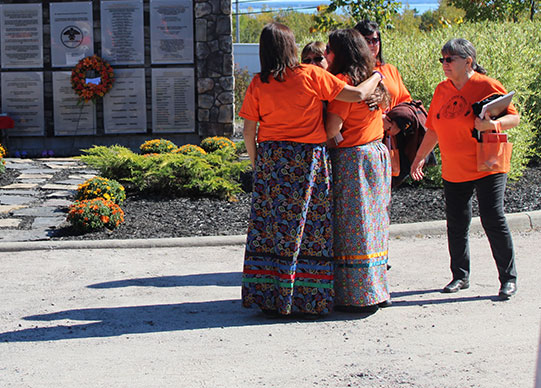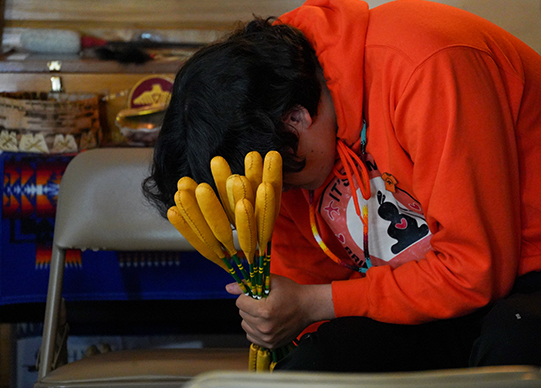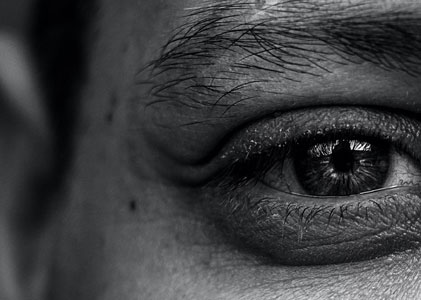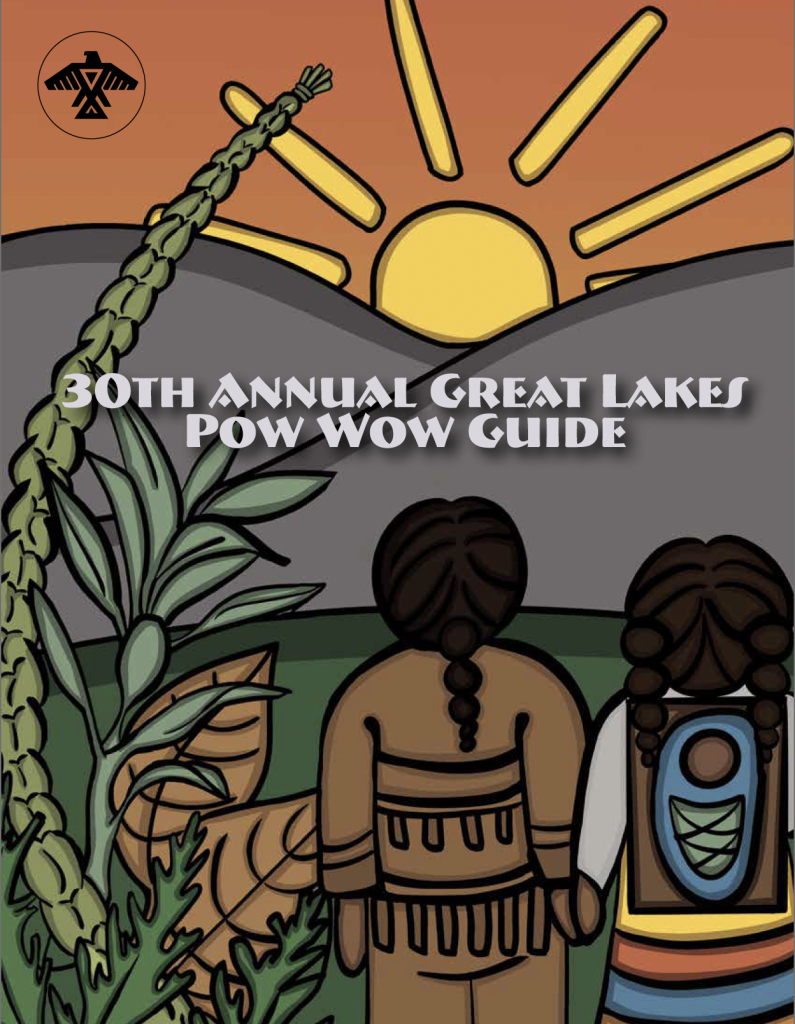
What is Trauma and Resilience?
This page contains information on the impacts of the Indian Residential School system to the Survivors, their families, and communities. It is adapted from the booklet, The Soul Wounds of the Anishinabek People: The Psychological and Intergenerational Impacts of the Indian Residential School System, by Dr. Brenda Restoule. C. Psych.
The legacy of the Indian Residential School System continues to be affecting the Survivors, their children, grandchildren, and communities they live in. These experiences can be found for individuals, families and communities in the mental, emotional, physical, social, economical and spiritual parts of their lives. Understanding the soul wounds or impacts this has had across the generations can assist in creating healing and wellness for Anishinabek people.

THE PSYCHOLOGICAL AND INTER-GENERATIONAL IMPACTS OF THE RESIDENTIAL SCHOOL SYSTEM
Cited from The Soul Wounds of the Anishinabek People, by Dr. Brenda M. Restoule, C. Psych (Waub-Zhe-Kwens, Migizi dodem), Dokis First Nation, Anishinabek Nation.
Through the Indian Residential School system, many First Nation children suffered neglect and physical, sexual, and psychological abuse, while also enduring harsh living conditions under the pretense of gaining an education. As a result, many children experienced personal and cultural degradation that lasted a lifetime for many of them.
The Survivors often believed these experiences to be traumatic and resulted in long-term negative impacts across many areas of their lives such as relationships, parenting, health, mental health, beliefs, and coping. Many of the Survivors were left without any supports or help to heal from the traumas they experienced in the Indian Residential School system. In some cases, the Survivors didn’t recognize some of their problems as being connected to the Indian Residential School experience. As the Survivors had families of their own, they unintentionally placed their children at risk of being exposed to these same long-term negative impacts. In doing so, they transmitted their trauma and the effects to their children who were often unaware of their parents’ experiences in the Indian Residential School system. This transmission of trauma is known as intergenerational trauma transmission and it has negative long-term impacts across the generations.
Presently, there is greater awareness of the serious negative experiences that the students and Survivors of the Indian Residential Schools were exposed to, trauma and its impacts, and the ability to transmit trauma across generations. As Survivors and their families speak out about the trauma, there are opportunities available using cultural and counselling supports to heal from their soul wounds.
What happened to the children while at the school?
Disclaimer: this is not a comprehensive list, nor does it identify the legacies of the Indian Residential Schools.
- Forcible removal of their cultural identity such as cutting of hair, stripped of traditional clothing and possessions
- Renamed with ‘Christian’ names or known only by a number
- Unsanitary and overcrowded conditions
- Exposure to illnesses such as tuberculosis with a lack of effective and immediate healthcare
- Inadequate food and clothing
- Physical, sexual, psychological, emotional, and spiritual abuse
- Forced replacement of spiritual beliefs by religious teaching
- Physical and emotional separation from parents, grandparents, extended family, siblings, and the opposite sex
- Death due to violence, suicide, malnourishment, disease, exposure to extreme weather conditions
- Loss of language
- Sexual abuse and assault
- Loss of cultural practices and customs
What are the long-term impacts to Survivors of the Indian Residential School system?
- Inability to express feelings about the abuse they suffered in the schools
- Internalized feelings of anger, fear, grief, shame, and guilt
- Substance abuse, addictions
- Self-sabotaging behaviours
- Violence directed toward others or self (i.e., suicide, self-harm)
- Risk-taking behaviours
- Avoidance
- Mental health problems such as anxiety, depression, and Post-Traumatic Stress Disorder (PTSD)
- Cultural alienation
- Poor or no interpersonal and relationship skills
- Lack of trust or belief in others or in a safe and predictable world
- Lack of loving and effective parenting skills
- Inability to effectively handle conflict in healthy ways
- Continuation of abuse of others
- Anger

TRAUMA
There are different types of trauma. Physical trauma is the result of a physical wound or injury. Psychological trauma is the result of extraordinarily stressful events that break a person’s sense of security and predictability, leaving one feeling helpless and vulnerable. It does not require a physical injury to be considered traumatic. Survivors of the Indian Residential School system often experienced psychological trauma and many report feeling alone, frightened, and overwhelmed.
Disclaimer: this is not a comprehensive list, nor does it identify the legacies of the Indian Residential Schools.
What are some causes of psychological trauma?
- It happens unexpectedly
- The person is unprepared for it
- The person feels powerless to prevent it
- It happens repeatedly
- Someone was intentionally cruel
- It happened in childhood
How does trauma happen?
- A single, one-time event (i.e., car accident, unexpected loss, assault)
- A prolonged or repeat experience (i.e., apprehension, abuse)
- A cumulative effect (i.e., violence + abuse +racism/discrimination)
- A historical event with prolonged impact (i.e., relocation)
Does trauma happen immediately?
It has the potential to have immediate effects but for some it can take weeks, months or years before the impacts of trauma are noticeable.
Are there long-term impacts to trauma?
Yes, there can be emotional, physical, mental, social, behaviourial and spiritual impacts.
What are the spiritual affects to trauma?
Persons may describe a lack of belief or faith in others, including a higher power.
What are the emotional impacts to trauma?
- Feeling nervous, helpless, fearful, sad
- Feeling shocked, numb and not able to feel love or joy
- Feelings of guilt or shame
- Avoiding people, places and things related to the event
- Being irritable or having outbursts of anger and aggressive behaviour
- Becoming easily upset or agitated
- Being withdrawn, feeling rejected or abandoned
- Loss of intimacy or feeling detached
- Feeling detached or unconcerned about others
- Feeling jumpy and getting startled easily at sudden noises
- Confusion
- Suicidal thoughts and behaviours
What are the mental impacts to trauma?
- Blaming yourself or having negative views of yourself or the world
- Distrust of others, getting into conflicts, being over controlling
- Having trouble concentrating or making decisions
- Feeling on guard and constantly alert
- Having disturbing dreams, memories or flashbacks
- Having work or school problems
- Short term memory loss
- Loss of interest in activities
- Decreased performance levels
- Increased difficulty in relating to others
- Sadness or depression
- Anxiety
- Post-traumatic stress disorder (PTSD)
What are the social impacts to trauma?
- Inability to relate to others
- Distrust in others
- Problems with parenting and intimacy
What are the physical effects of trauma?
- Headaches, aches and pains – including chronic pain
- Overeating or loss of appetite
- Bowel problems
- Skin problems
- Pounding heart, rapid breathing, feeling edgy
- Vomiting
- Ongoing medical problems getting worse
- Sleep problems such as nightmares, sleeping too much or not being able to fall or stay asleep
- Addictions such as alcohol or drug abuse including prescription drug abuse
What is Post-Traumatic Stress Disorder?
An anxiety disorder that involves reliving psychologically traumatic situations long after the physical danger involved has passed, through flashbacks, nightmares and other physical responses (i.e., poor eating and sleep)
Can trauma be transmitted to others?
Yes, impacts or reactions may be transmitted to the offspring (and subsequent generations) of victims of collective emotional or psychological trauma. This is known as intergenerational, historical or multigenerational trauma.
Does intergenerational trauma happen to First Nations people?
Yes, intergenerational trauma is directly linked to the banning of cultural practices, policies and institutions of assimilation, and loss of culture. It is a reaction to multigenerational, collective, historical wounding of the mind, emotions and spirit.
Why does intergenerational trauma happen?
Victims of trauma such as survivors of the Indian Residential School system display various behaviours and (negative) coping strategies that increase the likelihood of trauma transmission.
- Troubled with traumatic memories, behaviours and negative coping strategies they pass on to their children through modeling
- Limited ability and/or lack of knowledge and skills to assist their children in coping with difficult situations or emotional difficulties.
- Limited ability and/or lack of knowledge and skills to support their children in dealing with developmental transitions and milestones (i.e., moving from childhood to adolescence).
- Overprotective or neglectful of children and their needs
What are the impacts of intergenerational trauma?
- Addictions, alcohol or drug abuse
- Abuses: physical, sexual, emotional/psychological, mental, spiritual
- Low self-esteem
- Dysfunctional families and interpersonal relationships
- Poor parenting such as rigidity, neglect, abandonment, emotional coldness
- Suicide acts, thoughts and behaviours
- Teen pregnancy
- Depression, particularly chronic to individuals and widespread across the community
- Chronic and widespread anger and rage
- Eating and sleeping problems that are significant and chronic
- Chronic physical illness
- Chronic unresolved grief and loss
- Fear of personal growth, transformation and healing
- Fetal alcohol syndrome (FAS) and fetal alcohol effect (FAE)
- Unconscious internalization of residential school behaviours such as false politeness, not speaking out, passive compliance, excessive neatness, obedience without thought
- School based learning problems like fear of failure, avoiding learning that seems ‘too much like school’, learning disabilities with a psychological basis
- Spiritual confusion and alienation that doesn’t allow for growth
- Internalized sense of inferiority or avoidance to non-First Nation people
- Becoming abusers and oppressors of others
- Cultural identity issues including denial or refusal of cultural background, cultural identity confusion, fear of learning or practicing culture
- Disconnection from the natural world as an important part of daily life and spiritual beliefs
- Passiveness or having no voice
- High risk behaviours (i.e., sexual promiscuity)
- Early death
- Poor attachment to caregivers
Is it possible to see intergenerational trauma transmitted at the community level?
- Yes, many of the social, economic and political challenges in First Nation communities are directly or indirectly related to the residential school experience and other colonial factors. These may include:
- Paternalistic authority
- Passive dependency
- Patterns of misuse of power to control others
- Community social patterns that foster gossip and rumours but failure to support and stand with those who speak out or challenge the status quo
- Breakdown of ‘social glue’ that binds families and communities together such as trust, common ground, shared purpose and direction, a strong community life of giving and sharing, lack of volunteerism, co-operative groups/neighbourhoods working together for the benefit of all
- Conflict and lack of unity between individuals and families including factions within the community
- Conflicts and confusion over religious and spiritual based practices
- Toxic communication: gossip, criticism, personal attacks, sarcasm, secrets, put downs, etc.
- Destruction of social support network
- Passive acceptance of powerlessness with community life and/or governance
- Loss of traditional governance processes that gave people a sense of influence in shaping the community
- Joblessness and poverty
- Family violence
- Family breakdown
- Homelessness
- High rates of imprisonment




